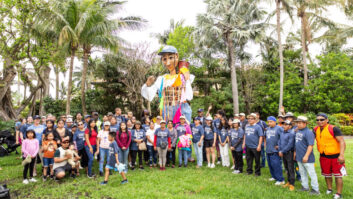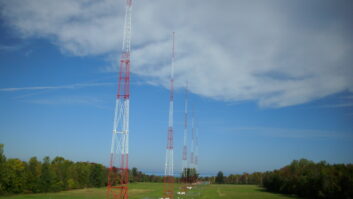It’s been a year now since the Federal Communications Commission regulation widely known as the “Main Studio Rule” was abolished. Local radio stations are no longer required to operate a studio and have a physical presence within the city-grade signal contour of their official city of license.
“I have not seen any widespread move to abolish studios and to consolidate operations,” says David Oxenford, partner in the D.C. law firm of Wilkinson, Barker, Knauer. He cautions that, “Stations still need to address the issues of importance to their community in their programming, and maintain a toll-free phone line that’s answered during normal business hours.”
Of course, those requirements can be fulfilled from a distance, and the Main Studio Rule itself was — in reality — treated as a formality at times, an expensive one.
A TRUE ONE-MAN STUDIO

For example, freelance broadcast and recording consultant/engineer Chuck Ide recalls installing remote control operations for KSRY(FM) in Tehachapi, Calif., in 2007.
“We followed the rule,” says Ide. The 103.1 signal began re-transmitting programming from sister KYSR(FM), about a hundred miles south in Los Angeles, and — in a practical sense — its day-to-day operations originate there, too. “We had a tiny local studio behind a Ford dealership. There was one lonely employee who reported to work every day as the official operator and general manager.”
In that case, Ide saw the logic of the strategy. The tiny Class A station — in LA’s shadow — hadn’t drawn much audience or revenue on its own, so providing a better signal to a nearby metro station made better business sense and still does.
“Now that the Main Studio Rule is gone, the KSRY transmitter sits in a windmill farm” with no local staff, he says.
OFFICE SHARING, NOT ELIMINATING
Matt Moore is the kind of young entrepreneurial broadcaster that local radio needs. He and his partner Brent Lee formed Spoon River Media to build their first station in 2016 — WILP(FM), licensed to Cuba, Ill. (population: 1,294). The studios are located in the larger town of Canton.
“We believe in being local, engaging and active in the communities we serve,” regardless of where the studios are, Moore says. “This rule change promotes efficiencies by sharing staff between offices, and that encourages our company to continue to grow.”

Oxenford says WILP is the type of situation in which he sometimes sees companies doing away with main studios. “These are often stations serving rural areas where a studio would be a burden without any benefit, but radio remains primarily a local business,” says Oxenford. “In the short term, I expect that most broadcasters will continue to operate with local studios. In the longer term, there may be some experimentation with more regionalized operations, especially if there is an economic downturn. But broadcasters will be able to determine the best choice based on their experience rather than some arbitrary regulatory requirement.”
LESS LOCALISM
Still, some industry veterans like Ide fear that the rule change could lead to more centralized operations for cost cutting reasons — with less local content and fewer jobs.
Ide explains, “As an example, what would stop a company from shifting all their operations from Riverside/San Bernardino over to Los Angeles? Why have a staff in Bakersfield? A music station in Tucson can now be contained in an equipment rack in Phoenix or New York.”
The technology to automate vast networks of stations from a distance has existed for years, says Ide. “All they needed was a rule change to drop the hammer.”
SATELLITE DELIVERY, LOCAL SOUND

Creating content for hundreds of stations from a central location is what satellite-delivered format services have done for years.
“When you do it right, radio that’s created from a distance can actually be very local sounding,” says Gary Thompson, who has been a programming executive with the former Dial Global and Westwood One networks. “If someone at the network is always researching a market, looking for local events and topics — and there’s a plan to work those in every hour — that’s more local content than many locally operated stations do.”
As for the imaging production of a radio station, “Who produces just one or two stations?” asks Thompson. “That job doesn’t exist anymore. At the network, I would often produce the imaging for 40 or 100 stations at one time.”
After creating the custom pieces that included station brand names and frequencies, the rest of the imaging tracks were essentially the same by format — identical effects, positioning slogans and song hooks. Assembling all those pieces manually was time consuming.
“I realized a monkey — or a computer — could do that part.” So Thompson spent 60 to 80 hours a week over a three-year period writing the code to invent ImagingThing.com. Virtually every radio brand name and imaging line you could imagine is stored on his site, and — with the click of a mouse — Thompson’s software creates ready-to-air customized radio production in just seconds.
Will tools like these cause fewer people to be employed in local radio? “This is a continuation of a trend that started decades ago,” says Thompson. “If the industry is changing, you need to change to stay relevant. Whether it’s creating audio production on a larger scale, building a large loyal fan base as an air personality, shooting and editing video for social media, mastering new technologies, whatever… Learn the skills to become indispensable.”
While being “live and local” has been a popular battle cry in radio,“topical and relevant” content may be what radio’s future listeners and owners come to value more. Where it originates may not matter.
After 9 1/2 years as the creator of LA’s 100.3 The Sound, Dave Beasing has launched SoundThatBrands.com, the company that co-produces the popular “Inside Trader Joe’s” podcast with fellow radio veteran Steve Goldstein.







